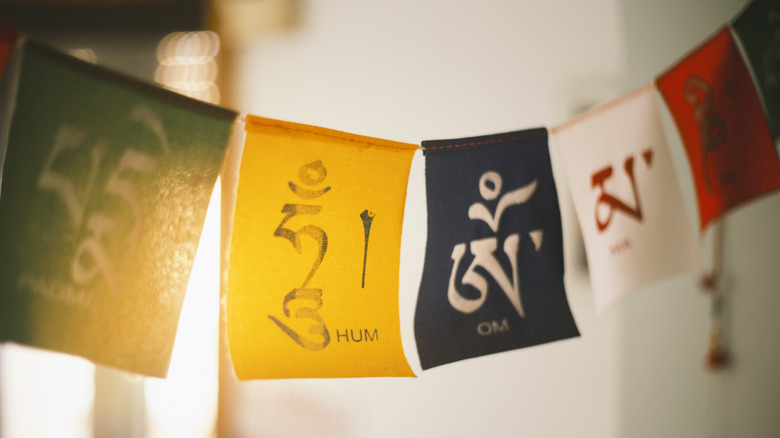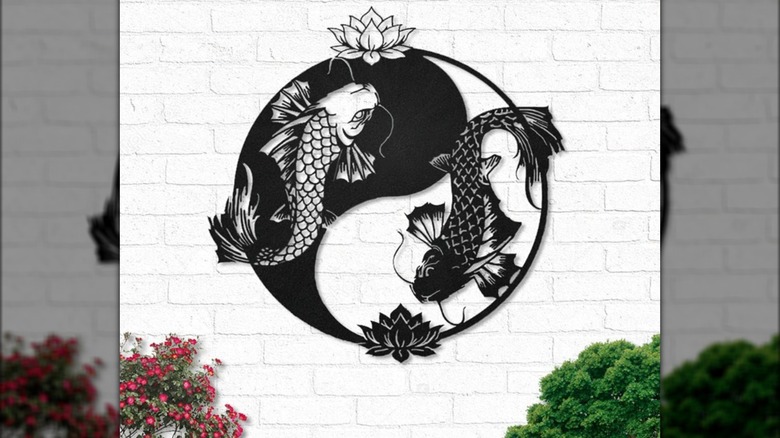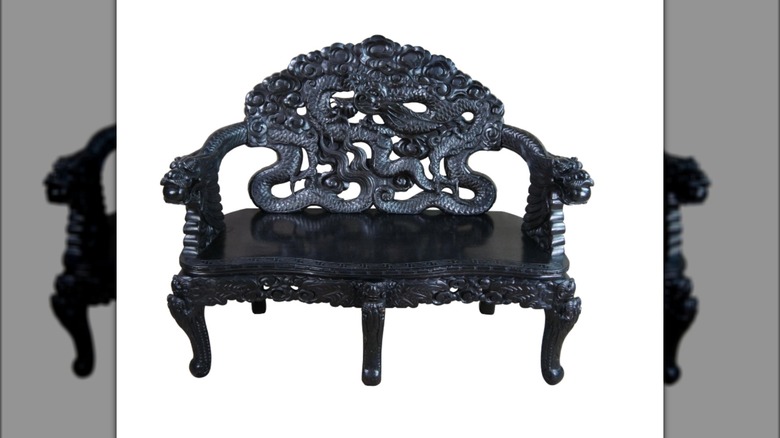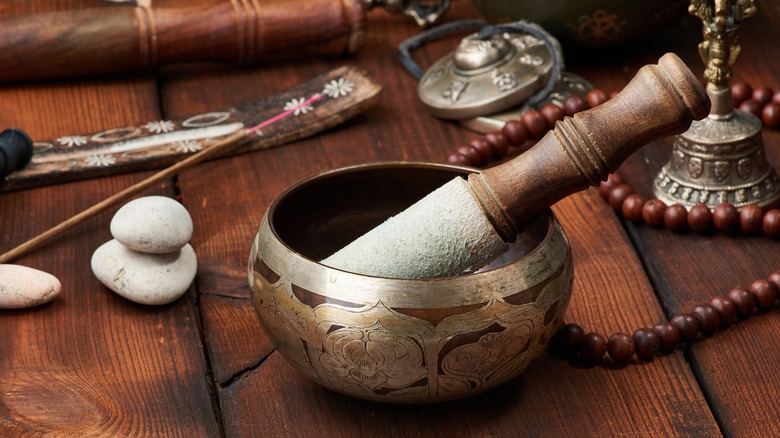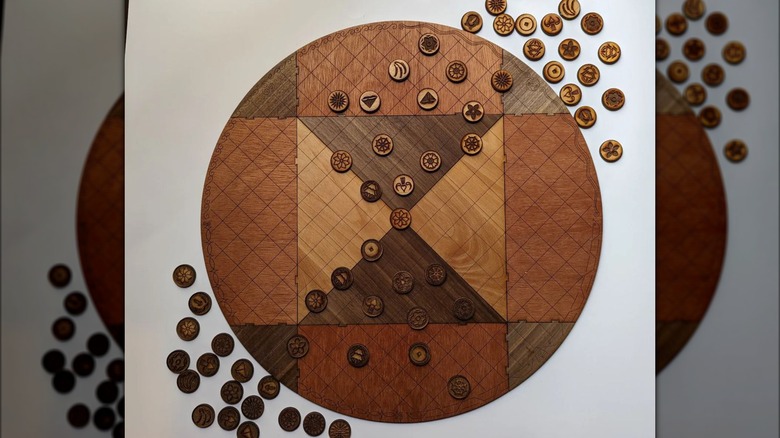5 Classy Ways To Incorporate Avatar: The Last Airbender Into Your Home Decor
We may receive a commission on purchases made from links.
When "Avatar: The Last Airbender" debuted on Netflix in May 2020, fans old and new alike were enthralled by arguably the best-made animated TV series ever. In fact, the groundswell of love for the Avatarverse hasn't stopped. Per IndieWire, the fandom's renaissance has led to multiple new "Avatar" projects in development.
A defining feature of "Avatar" is the complex and sensitive approach to worldbuilding (via The New York Times). Avatar's world is divided into four nations, each defined by an element that some gifted natives are able to control — a.k.a. "bending." Although the aesthetic of the series is clearly influenced by Asian culture, casual fans might not realize the nations and bending styles were created with specific blends of Asiatic and Indigenous cultures, philosophies, and styles in mind.
This inclusive approach set the foundations for Avatar's success (per Stanford Daily), but still receives criticism for cultural appropriation. As the Harvard Political Review points out, "Avatar" celebrates Asian culture, but almost everyone profiting from it is White.
The great news is that the cultural cornucopias that inspired the smash series are still here, relevant, and in some cases, in need of support. If certain characters or cultures resonated with you, you'll really enjoy getting to know the real-life cultures that inspired them. In doing so, you'll get the added benefit of playing the part of a cultured, urbane individual with eclectic taste — all from a cartoon on Nickelodeon! Keep reading to find out more.
The Water Tribe — Inuit and Yup'ik Cultures
For a subtle dip into the Water Tribe aesthetic, this Yin-Yang Koi wall hanging from Amazon is a nice reference to the Spirit Oasis, where Tui and La, the Moon and Ocean spirits, circle each other in their endless dance of push-and-pull.
For a deeper dive, remember the Water Tribes are polar-dwelling peoples, inspired by the Indigenous Yup'ik and Inuit cultures. This is an exciting time for polar Indigenous art and design, with the opening of the Qaumajuq and the first all-Inuit curated museum exhibition of Inuit art, INUA (via Winnipeg Free Press).
A new wave of Indigenous artists, including Golga Oscar, a Yup'ik designer and teacher, are reimagining fashion and culture (via Vogue). However, the future of native people and their traditions is far from guaranteed, and there's still much work to be done. "I really want to inspire the younger generation to pursue their cultural identity, and what that means in the 21st century," said Oscar, via Vogue.
The classiest way to incorporate the Water Tribe in your home is to support Indigenous artists. The beauty they and their forebears created is at the heart of "Avatar," so it feels good to support them as they work to uphold their traditions. Nanooq is Canada's online Inuit art shop, and Art for Aid is a Métis-owned organization that also supports Inuit cultural education programs. For authentication, look for the Igloo tag when buying Inuit art, per the Inuit Art Foundation.
The Fire Nation — Imperial Japan
In the beginning, the Fire Nation just seems like a bunch of scary guys who keep showing up and ruining Team Avatar's day. Of course, when we scratch the surface, things are nowhere near so simple. According to Syfy, the most direct real-world inspirations for Fire Nation culture are the Meiji and Taishō eras of Imperial Japan (1868-1926), though Thailand and other places are also represented. At that time, Japan was rapidly industrializing, and, citing the justification of spreading prosperity throughout Asia, rapidly militarizing as well.
So we can see parallels in the stories of Japan and the Fire Nation, and there are aesthetic similarities, too. Indeed, this antique dragon bench from the Meji period (via 1stdibs) could have come right from Fire Lord Ozai's bedroom, and it can be yours for $3,300.
The palace interior is mainly luxury red propaganda, and the ships, prisons, and barracks are fairly minimalist and spartan. However, Ember Island, the tropical Fire Nation getaway, offers us a more intimate glimpse of Fire Nation life. The creators stated that Ember Island includes plenty of references to Thai architecture and design (via Avatar Wiki). But these are still the holiday homes of the country's elites, and in the house party scene, there are some Japanese-style silkscreen paintings adorning the walls. This style of art is beautiful, adaptable, and inexpensive. Plus, you can double up on Imperial Japanese vibes with pieces like this shoji screen from Haiku Designs.
The Earth Kingdom — Qing Dynasty China
The Earth Kingdom is a diverse and sprawling empire, incorporating more area, people, and cultures than any other. The Kyoshi warriors reference Japanese kabuki and samurai, and some peasant outfits mirror styles common in Korea. However, the most important cultural references for the Earth Kingdom are those to Qing-era China.
The crest of the Earth Kingdom itself, a square within a circle, has held profound meaning in China throughout the ages. Chinese coins have been circular with square holes since 221 BCE, according to China Sage. The shape represents the union of heaven and earth, which is quite fitting for the Earth Kingdom. As luck would have it, these coins are one of the eight Qi-boosting treasures of feng shui believed to bring increased wealth, prosperity, and abundance, per Housing.com. Coins should be strung together with red ribbon in multiples of three and hung at your home's entrance, or in the far left corner, which is the wealth corner.
Earthbending prodigy Toph is so attuned to the Earth that her feet feel vibrations and "see" without her eyes. Her bending is unique, as she adopted her style from nature's earthbenders — the badgermoles (via AvatarWiki). Classical Chinese garden design mirrors this by recapturing nature's patterns in miniature, per UNESCO. The best examples of this, such as the Humble Administrator's Garden, are in the historic city of Suzhou. These Etsy fine art prints are one way to bring those ideas into your home décor.
The Air Nomads — Tibetan Buddhists
The culture of the Air Nomads is heavily influenced by that of Tibetan Buddhists — especially the central character of the series, Aang, the titular "Last Airbender." According to Men's Health, the very idea of the "Avatar," the generational cycle of rebirth, and the methods by which they are located as children are based on the real-life title of Dalai Lama — a post currently occupied by His Holiness, Tenzin Gyatso. It's no accident that Monk Gyatso and Councilman Tenzin are both prominent Air Nomad leaders in the series.
According to Brown University, Tibetan art is "entirely and exclusively" religious and, due to the nature of Buddhism, philosophical as well. The Air Nomads lived in amazing sky temples and were famously vegetarian, peace-loving, and egalitarian. If you're thinking about bringing a little more Air Nomad into your living space, then you have some phenomenal options to incorporate a little philosophy as well as beauty. Though direct access to Tibet is tricky and ethically fraught, organizations like Dharma Shop and others work with Tibetan communities in other countries to bring authentic artisan handcrafts directly to consumers.
The Order of the White Lotus
The White Lotus in the world of Avatar is a secret society that reaches beyond the boundaries of the four nations, keeping secret knowledge and often looking out for the Avatar. In real life, there was a White Lotus society in China, originating in 368 CE as a radical Buddhist debating society (via The Met). According to China Knowledge, this sect was responsible for the downfall of more than one of China's ruling dynasties over the years. At times, the White Lotus was outlawed and, during others, it was a crucial part of religion and government, which is why it was such a good fit for a secret society of high-level officials in the TV series.
A crucial part of how the White Lotus members identify themselves to each other is via the in-universe game Pai Sho. It's similar to classic Chinese board games like Go, Chinese Checkers, and Xiangqi, per Avatar Wiki, but the rules are never explained in-game. However, over the years, fans have come together to establish rules and even created an online-playable version called Skud Pai Sho, according to Glowforge. Nothing says "Avatar: The Last Airbender" class like a nicely carved Pai Sho board on a coffee table. If you want to indulge your inner Iroh, there are several online suppliers, according to The Garden Gate.
